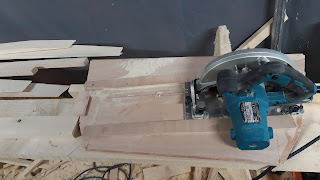For the cabin frames which are unsupported by bulkheads I chose to go oversize and used over-dimensioned timber. That is 6cm width instead of the 5-point-something. Since I use a lighter wood species it gives me about the same weight per frame as specified in the design. Should be OK.
The frames got bunk supports built right in, will make it easier to keep the bunks and everything aligned and level after the hull is assembled.
The hull forward of frame D starts to have a curvature under the water line, the frames need to reflect that. Since I did not have a wider plank I glued up some wide enough to support the curvature:
Also here a support for the bunks gets built in, and a small bulkhead to stiffen up the hull. Parts of the bulkhead might go away later on to allow for easy access to stowage.
All ready and curing on the floor:
Frame E has an even larger curvature, the drawing seems to suggest something like this: a sagitta of ~4cm (unless I read the drawing wrong). We'll see how the plywood will bend around that, but for now is is what is is.
Also here, some glue up is needed:
Bunk support and a brace for either a wet locker bottom or just internal stowage. The important part is that the space in between is free so that the v-berth has some leg room all the way forward to the stem.
Following the recommendations of many (including proper literature) the glue-ups are (mostly) done using the most time consuming and labour intensive method I can imagine:
First, pre-wet the surfaces with un-thickened epoxy to allow for some penetration and saturation. Working with a brush is tough with resin as thick as the one I'm using, so I use a putty knife to spread the goop in a thin layer:
Same on the side of the plywood:
After the first layer tacks up, put some thickened epoxy on and glue away:
... and the final result:
Here the screws used to provide clamping pressure while curing the joints are already replaced by glued in oak trennels. Since these joints (frame-to-gusset and frame-to-bulkhead) will be loaded mostly in the shear direction a larger and stiffer fastener will do as well or better than just a 4mm screw in soft wood. I will make a separate post on the issue of peg vs. screw.










































